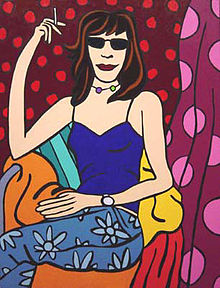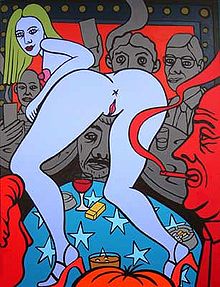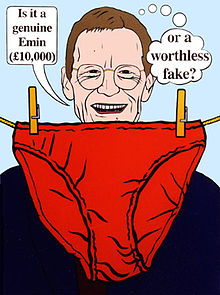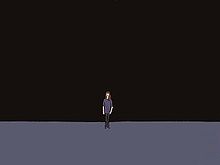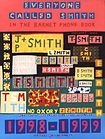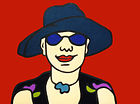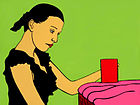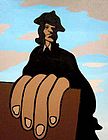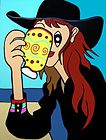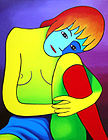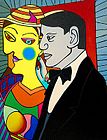- Charles Thomson (artist)
-
Charles Thomson 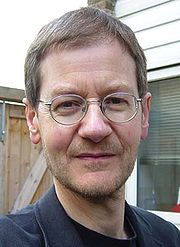
Charles ThomsonBorn 6 February 1953
Romford, EnglandNationality British Field Painting Training Maidstone College of Art Movement Stuckism Works Sir Nicholas Serota Makes an Acquisitions Decision Charles Thomson (born 6 February 1953) is an English artist, painter, poet and photographer. In the early 1980s he was a member of The Medway Poets. In 1999 he named and co-founded the Stuckists art movement with Billy Childish. He has curated Stuckist shows, organised demonstrations against the Turner Prize, run an art gallery, stood for parliament and reported Charles Saatchi to the OFT. He is frequently quoted in the media as an opponent of conceptual art. He was briefly married to artist Stella Vine.
Contents
Early life
Charles Thomson was born in Romford, London Borough of Havering, East London, England, and educated at Brentwood School, Essex, where he was class mates with Douglas Adams. While still at school he organised mixed media arts events and contributed to Broadsheet, a magazine edited by Paul Neil Milne Johnstone and published by Artsphere, a school arts group.[1] Outside school, he started the Havering Arts Lab. this resulted in a headline "Sex Orgy Tale—Group Banned" in the local Havering Express newspaper. In 1971 he stood (unsuccessfully) as a Dwarf candidate in the Havering council elections, and was involved in anti-pollution protests. He distributed "underground" magazines around London, including "Schoolkids Oz". In 1975 he went to Maidstone College of Art, where he was the only person in ten years to fail the painting degree. 1979–87 he worked part-time as a telephonist and receptionist at Kent County Ophthalmic and Aural Hospital. 1987–99 he was a full-time poet, with work in over 100 anthologies.[2]
The Medway Poets
Main article: The Medway Poets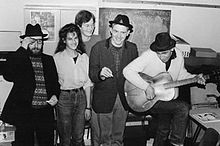 Sexton Ming, Tracey Emin, Charles Thomson, Billy Childish and musician Russell Wilkinson at the Rochester Adult Education Centre 11 December 1987 to record The Medway Poets LP
Sexton Ming, Tracey Emin, Charles Thomson, Billy Childish and musician Russell Wilkinson at the Rochester Adult Education Centre 11 December 1987 to record The Medway Poets LP
In 1979, Thomson was a founder member of The Medway Poets, a punk performance group, who read in pubs, as well as the Kent Literature Festival and the 1981 international Cambridge Poetry Festival. There were, however, personality clashes in the group, particularly between Billy Childish and Thomson, who said, "There was friction between us, especially when he started heckling my poetry reading and I threatened to ban him from a forthcoming TV documentary." [3] However, a TV South documentary on the group in 1982 brought them to a wider regional audience. According to Childish: "Me & Charles were at war from 1979 until 1999. He even threatened having bouncers on the doors of Medway poet’s readings to keep me out."[4] Thomson has said this period was "an incredibly pressured and creative time and established the basis on which we are still working."[5] Other members included future Stuckist artists Bill Lewis and Sexton Ming. Tracey Emin, then a local student, was on the out skirts of the group, being the girlfriend of Billy Childish. In 1987 Thomson printed her first book of writing, Turkish Tales, which had been edited by Lewis and was published by Childish.[6]
Stuckism
Main article: StuckismIn 1999 Thomson was reconciled with Childish and together they founded the Stuckists art group with eleven other artists. Thomson coined the name "Stuckism" after an insult from Tracey Emin to ex-boyfriend Childish that he was "stuck", which Childish had recorded in a 1993 poem. The group stated its aims as promoting figurative painting and opposing conceptual art, being particularly critical of the Turner Prize and Charles Saatchi's promotion of Britart. Childish left the group in 2001 and Thomson remained as the figurehead, gaining extensive media coverage for his activities and outspoken views. In the meantime the Stuckists grew to a worldwide movement of over 100 groups in 30 countries.
2000-5 he staged yearly Stuckist demonstrations against the Turner Prize (making use of props such as clown costumes and blow-up sex dolls). He stood in the United Kingdom general election, 2001, as a Stuckist candidate against the then-Culture Secretary, Chris Smith. The same year he exhibited the then-unknown artist, Stella Vine (later made famous by Charles Saatchi). The couple married in New York and separated after two months.
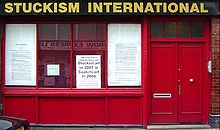 The Stuckism International Gallery, Shoreditch, London.
The Stuckism International Gallery, Shoreditch, London.
Thomson opened the Stuckism International Gallery in Shoreditch (2002–2005). In 2004 he reported Saatchi to the OFT (Office of Fair Trading) for alleged unfair trading practices in the art world: the complaint was not upheld. He co-curated the Stuckists' first major exhibition in a public gallery, The Stuckists Punk Victorian show at the Walker Art Gallery, for the 2004 Liverpool Biennial. In 2005 he offered of a donation of 175 paintings by Stuckists artists from the Walker Gallery show to the Tate Gallery: this was rejected by the trustees. Later that year he obtained Tate Gallery minutes about the purchase of a trustee Chris Ofili's work The Upper Room under the Freedom of Information Act. This led to an ongoing press controversy about the purchase[7] and resulted into an official investigation by the Charity Commission, who censured the Tate in July 2006 for acting outside its legal powers.[8]
In June 2006 he wrote to the British Prime Minister Tony Blair asking him to intervene in the case of Stuckist artist Michael Dickinson, who was facing a possible 3 year jail sentence in Turkey for exhibiting a satirical collage of the Turkish Prime Minister Recep Tayyip Erdoğan.[9][10]
In October 2006, Thomson exhibited paintings and presented an academic paper in both the Triumph of Stuckism exhibition and symposium respectively . Both these events were organised by Naive John for the 2006 Liverpool Biennial at the invitation of Professor Colin Fallows, Chair of Contextual Studies at Liverpool School of Art and Design.
He writes a regular arts column for 3:AM Magazine, which carries work by a number of Stuckists, ex-Stuckists and their opponents.
Stella Vine
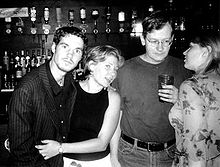 Left to right: Stephen Howarth, friend, Charles Thomson and Stella Vine at the Vote Stuckist show in 2001, where Vine exhibited her work publicly for the first time.[11]
Left to right: Stephen Howarth, friend, Charles Thomson and Stella Vine at the Vote Stuckist show in 2001, where Vine exhibited her work publicly for the first time.[11]
In June 2000, Thomson gave a talk with Childish at the Salon des Arts in Kensington on Stuckism and Remodernism. It was attended by Stella Vine,[12] who was following Childish after developing a "crush" on him.[13] She subsequently met Thomson[13] on 30 May 2001 at the private view of the Vote Stuckist show in Brixton, where she accepted his invitation to form The Westminster Stuckists group and to exhibit some of her paintings publicly for the first time in the show.[11] On 4 June, she took part in a Stuckist demonstration in Trafalgar Square at the unveiling of Rachel Whiteread's sculpture there.[12][14] On 10 July, she renamed her group The Unstuckists.[15] In October she had a painting in the first Stuckist show in Paris, curated by Elsa Dax.[12]
Thomson and Vine had a two month relationship and they married on 8 August 2001 in New York.[16] The next day, Vine said she wanted a divorce; they had an intense row, their room in the hotel was "trashed" and Vine told Thomson that she was refusing to have sex with him.[17][18] She left him and they did not meet again till a week later at East India Club in St James's Square, London.[19] They finally consummated their marriage.[13] He said that eventually he was unable to cope with her vacillations,[17] and she said she could not cope with his controlling behaviour.[18] The marriage ended in 2001 after about two months.[20][21] They were granted a divorce in October 2003.[22]
In February 2004, after Vine "rose to fame after being championed by Charles Saatchi",[23] Thomson said that he was pleased that she had got success, but it was he and the Stuckists, not Saatchi, who had "discovered" Vine.[24] Vine said that Stuckism was a misogynistic cult,[22] that she had quickly realised that the marriage and the Stuckist group were not right for her,[25] and that her marriage to Thomson was "an utter disaster".[25] During the relationship Thomson had paid off Vine's debts of £20,000,[18] and Vine said she married him because this had been a condition of his funding her:[18] "I couldn't face stripping any more and it was too bloody good to turn down."[18] Thomson said that they had a business arrangement to promote themselves as an art couple, there was no condition of marriage, and that she was "really selling herself short" by saying that was her motivation.[26]
In March 2004, Vine said that she had only seen Thomson once, in an art shop, in the previous two years.[18] She later told The Times that it was "impossible to explain"[27] why she married Thomson, that he didn't "give a s*** about art or the Stuckist movement",[27] and that he saw her as a means of gaining his own publicity: "When I met him and he saw some of my history, he saw dollar signs. He is a very exploitative man."[27] Thomson said she showed herself in a manner to gain the largest amount of attention or sympathy, avoided reality and created a fantasy world : "Now it makes me question a lot of things she told me about her past."[17] In June 2007, Vine said that the marriage was consummated in 2001, a few weeks after the ceremony—"I owed him that"[13]—and Thomson then paid off her debts of £20,000, after which "I've never seen him again."[13]
On 28 March 2004, Thomson reported Saatchi to the Office of Fair Trading (OFT) for alleged breaches of the Competition Act and cited as an example Saatchi's promotion of Vine, a situation which made the row "more bitter".[28] The OFT said they did not "have reasonable grounds to suspect that Charles Saatchi is in a dominant position in any relevant market", which Thomson said was "just another cruel smack in the face" for Saatchi.[29] In September 2004, Vine threatened suicide if her work was included in the The Stuckists Punk Victorian show at the Liverpool Biennial, and the owner of the painting withdrew it.[30]
In October 2006, The Stuckists held a group show, Go West, at Spectrum London gallery, including two of Thomson's paintings, Stripper and Strip Club, "explicit images of his ex-wife."[31] Thomson said the works would make Vine "pissed off",[32] but that she had painted images that were far more upsetting for people,[32] that he would prefer her to enjoy them as he did her art[33] and that they were painted as a catharsis not as an attack.[32] Vine said she had no comment.[32]
In July 2007, at the same time as the opening of Vine's major solo show at Modern Art Oxford, Thomson, furious[34] at Vine's refusal to acknowledge her debt to the Stuckists,[34] held a rival Stuckist show at the A Gallery in Wimbledon, I Won't Have Sex with You as Long as We're Married, which Vine apparently said to him on their wedding night.[34]
In September, Thomson wrote in The Jackdaw, criticising the Tate gallery for not having work by a number of figurative painters, among whom he listed Vine,[35] and said she should have been one of that year's Turner Prize nominees for her show at Modern Art Oxford.[36]
Sir Nicholas Serota Makes an Acquisitions Decision
Main article: Sir Nicholas Serota Makes an Acquisitions DecisionHis satirical painting of Sir Nicholas Serota, Sir Nicholas Serota Makes an Acquisitions Decision, has been widely reproduced in the media and become a Stuckist icon. It has been reviewed:
“ Thomson has painted what must be the masterpiece of Stuckism so far: Sir Nicholas Serota Makes an Acquisitions Decision. Here the slick handling and smartass irony of Britart are turned on its champion to make a very funny point and a rather good portrait. This is an example of what the Situationists called detournement, using your enemies' own weapons against him.[37] ” However, Sarah Kent (a staunch advocate of Britart) was less impressed with the satire: "One might forgive his puerile humour if Thomson didn't consider it a serious weapon ... cut the ranting and Thomson could be a reasonable painter."[38]
Thomson pointed out in response, "it's reality. A few weeks after I did the painting, Tracey Emin was shown on TV getting very angry about an installation because someone had substituted another pair of knickers for hers ... That makes it a bit sad."[39]
In October 2006, Thomson's painting of Serota was exhibited during the Stuckists' Go West show at Spectrum London gallery in London. It was suggested that this could be seen as revenge for the Tate's rejection of a Stuckist donation of 175 paintings the previous year.[40]
Art technique
Thomson typically paints figuratively with black outlines and areas of flat colour, often brightly coloured. The painting, I Feel Bad When I Reject Your Love is not typical in this respect. He said:
- Based on something a (now ex) girlfriend said to me. I thought it was a negative picture, but then I realised it was positive because it’s a reconciliation after self-knowledge. It’s also ambiguous as to who’s speaking. Most of my paintings are based on experiences with people I know, usually on a drawing from life, but in this case from a photo I took of her.[2]
The paintings are based on spontaneous line drawings with a black wax crayon in a sketchbook. These are enlarged on the canvas. The colour is usually the first one on the canvas, though mixing it can take up to an hour. He likens colour to feeling and concludes, "The final image is a synthesis of material, emotional and spiritual experience."[2]
Gallery
See also
Notes and references
- ^ Broadsheet, n.d., edited Paul Johnstone, Artsphere
- ^ a b c Milner, Frank, ed., The Stuckists Punk Victorian, p.106, National Museums Liverpool, 2004, ISBN 1-902700-27-9
- ^ Interview with Charles Thomson on 3ammagazine.com
- ^ "Billy Childish on Stuckism", trakmarx.com Accessed 9 April 2006
- ^ Interview with Charles Thomson on artistica.com
- ^ Milner p.8
- ^ "Tate buys trustee Chris Ofili's work The Upper Room for £705,000: Press coverage" stuckism.com. Retrieved 16 January 2009.
- ^ Alberge, Dalya (2006)"Tate's Ofili purchase broke charity law" The Times online, 19 July 2006. Accessed 19 July 2006
- ^ "Blair asked to help artist facing jail" The Sunday Times online, 11 June 2006. Accessed 12 June 2006
- ^ "Erdoğan'ı kızdıran kolaj için Blair devreye girdi" Vatan (in Turkish) online, 12 June 2006. Accessed 12 June 2006
- ^ a b Thomson, Charles (August 2004), "A Stuckist on Stuckism: Stella Vine", from: Ed. Frank Milner (2004), The Stuckists Punk Victorian, p. 23, National Museums Liverpool, ISBN 1-902700-27-9. Essay text available on line at stuckism.com.
- ^ a b c "Stella Vine the Stuckist in photos", Stuckism. Retrieved 18 December 2008.
- ^ a b c d e Januszczak, Waldemar. "The Paint Stripper", The Sunday Times, 10 June 2007. Retrieved 12 December 2008.
- ^ "New sculpture in London's Trafalgar Square", Getty Images, 4 June 2001. Retrieved 6 January 2008.
- ^ Stuckism news: Westminster Stuckists come unstuck", stuckism.com, 10 July 2001. Retrieved from Internet Archive, 9 January 2009.
- ^ "Trouble and strife", Evening Standard, p. 12, 20 August 2001.
- ^ a b c Johnson, Angella. The Mail on Sunday (London), 7 March 2004, p. 38. Retrieved 18 December 2008.
- ^ a b c d e f Deveney, Catherine. "Stripped bare", Scotland on Sunday, 14 March 2004. Retrieved on 17 December 2008.
- ^ "Trouble and strife", Evening Standard (London), p. 12, 20 August 2001.
- ^ Barber, Lynne. "Vine Times", 8 July 2007. Retrieved 16 January 2009.
- ^ "Charles Thomson: The Stella Vine paintings", stuckism.com. Retrieved 23 January 2009.
- ^ a b Billen, Andrew. "I Made More Money As A Stripper...", 15 June 2004. Retrieved 9 December 2008.
- ^ Akbar, Arifa. "Autism charity attracts titans of the art world", The Independent, 22 October 2007. Retrieved 18 December 2008.
- ^ Alleyne, Richard. "First blood to Saatchi as a star is born", 'The Daily Telegraph, 24 February 2004. Retrieved 9 December 2008.
- ^ a b "The Money Issue: answer the questions! Stella Vine - Princess Diana, Prozac and private views", The Independent on Sunday, 7 March 2004. Retrieved 18 December 2008.
- ^ Johnston, Ian. "Former husband of artist Vine denies paying her to marry him", Scotland on Sunday, 21 March 2004. Retrieved 18 December 2008.
- ^ a b c Malvern, Jack. "Saatchi dragged into artists' dispute", The Times (print edition), 5 April 2004.
- ^ Stummer, Robin. "Charles Saatchi 'abuses his hold on British art market'", The Independent on Sunday, 28 March 2004. Retrieved 17 December 2008.
- ^ Thomson, Charles (August 2004), "A Stuckist on Stuckism: Charles Saatchi and the OFT attack", from: Ed. Frank Milner (2004), The Stuckists Punk Victorian, p. 23, National Museums Liverpool, ISBN 1-902700-27-9. Available online at stuckism.com.
- ^ Pia, Simon. "Now the Stuckists are on the move", The Scotsman, p. 22, 22 September 2004.
- ^ Barnes, Anthony. "Portrait of an ex-husband's revenge" The Independent on Sunday, 3 September 2006. Retrieved 9 October 2006.
- ^ a b c d Barnes, Anthony. "Portrait of an ex-husband's revenge: The vicious feud between artists Charles Thomson and his former wife, Stella Vine, has spilled over on to canvas.", The Independent, 3 September 2006. Retrieved 18 December 2008.
- ^ Thomson, Charles. "Paint Stripper", Letters, p. 40, The Independent on Sunday, 10 September 2006.
- ^ a b c Moody, Paul. "Everyone's talking about Stella Vine", The Guardian, 12 July 2007. Retrieved 9 December 2008.
- ^ The Jackdaw, September/October. Online at 3ammagazine.com.
- ^ "Stuckists launch their annual protest against the Turner Prize at Tate Britain", Culture24, 29 September 2008. Retrieved 8 December 200.
- ^ Dean, Richard (2000)"The Real Turner Prize Show 2000" Imagespeak. Accessed from superhumanism.com, 17 April 2006
- ^ Kent, Sarah (2002) "The Stuckists: Stuckism International Time Out, 7 August 2002. Retrieved from stuckism.com, 18 April 2006
- ^ "Sarah Kent of Time Out Rants" stuckism.com 7 August 2002. Retrieved 18 April 2006
- ^ Teodorczuk, Tom (2006) "Modern art is pants" Evening Standard, 22 August 2006. Retrieved 9 October 2006.
Further reading
- Evans, Katherine, ed. (2000), "The Stuckists" Victoria Press, ISBN 0-907165-27-3
External links
- 2007 Interview with "the thing is..." magazine
- Paintings
- 2002 interview
- 2006 interview
- Heyoka Magazine Interview
- Essay for Walker Gallery catalogue
- Photography by Charles Thomson
- Detail from I Feel Bad When I Reject Your Love
- Triumph of Stuckism symposium official site
- Interview with Brian Sherwin for Myartspace
- Stella Vine
Stuckism International Main articles Stuckism · List of Stuckist artists · List of Stuckist shows · Stuckist demonstrations · Stuckism in the United States · Stuckism in Australia · Anti-anti-art · Charles Thomson, Stella Vine, and the StuckistsCo-founders Billy Childish · Charles ThomsonFirst group Philip Absolon · Frances Castle · Sheila Clark · Eamon Everall · Ella Guru · Wolf Howard · Bill Lewis · Sanchia Lewis · Joe Machine · Sexton Ming · Charles WilliamsArtists in Europe Elsa Dax (France) · Guy Denning (France) · Michael Dickinson (Turkey) · Robert Janás (Czech) · Peter Klint (Germany) · Odysseus Yakoumakis (Greece)Artists in UK Gina Bold · John Bourne · Mark D · Paul Harvey · Stephen Howarth · Alexis Hunter · Abby Jackson · Naive John · Rachel Jordan · Jane Kelly · Emily Mann · Peter McArdle · Mandy McCartin · Peter Murphy · Rémy Noë · Udaiyan · Stella VineArtists in US Peggy Clydesdale · Jeffrey Scott Holland · Tony Juliano · Frank Kozik · Terry Marks · Jesse Richards · Nicholas WatsonArtists elsewhere Godfrey Blow (Australia) · Asim Butt (Pakistan) · Mike Mayhew (New Zealand) · Regan Tamanui (Australia)Artworks Shows The Stuckists Punk Victorian · Go West · Addressing the Shadow and Making Friends with Wild Dogs: Remodernism ·Galleries Related groups Stuckism opposed by Stuckism opposed to Wikimedia Artists' names in italics indicate artists no longer in the movement (as of June 2007) Categories:- 1953 births
- Living people
- English artists
- English painters
- Contemporary painters
- People from Romford
- Alumni of the University for the Creative Arts
- Stuckism
Wikimedia Foundation. 2010.

